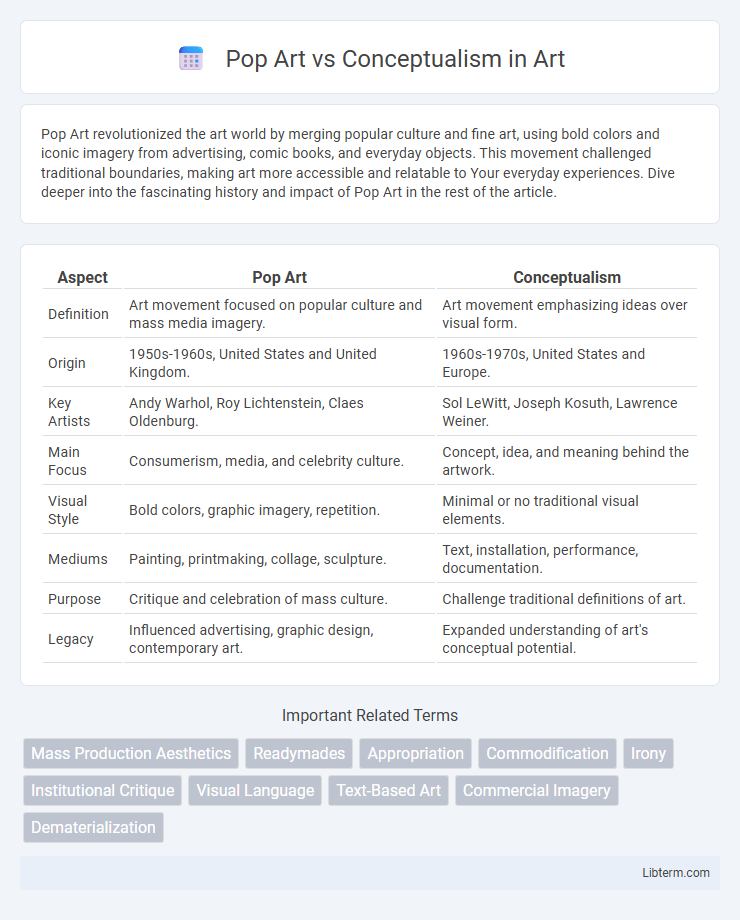Pop Art revolutionized the art world by merging popular culture and fine art, using bold colors and iconic imagery from advertising, comic books, and everyday objects. This movement challenged traditional boundaries, making art more accessible and relatable to Your everyday experiences. Dive deeper into the fascinating history and impact of Pop Art in the rest of the article.
Table of Comparison
| Aspect | Pop Art | Conceptualism |
|---|---|---|
| Definition | Art movement focused on popular culture and mass media imagery. | Art movement emphasizing ideas over visual form. |
| Origin | 1950s-1960s, United States and United Kingdom. | 1960s-1970s, United States and Europe. |
| Key Artists | Andy Warhol, Roy Lichtenstein, Claes Oldenburg. | Sol LeWitt, Joseph Kosuth, Lawrence Weiner. |
| Main Focus | Consumerism, media, and celebrity culture. | Concept, idea, and meaning behind the artwork. |
| Visual Style | Bold colors, graphic imagery, repetition. | Minimal or no traditional visual elements. |
| Mediums | Painting, printmaking, collage, sculpture. | Text, installation, performance, documentation. |
| Purpose | Critique and celebration of mass culture. | Challenge traditional definitions of art. |
| Legacy | Influenced advertising, graphic design, contemporary art. | Expanded understanding of art's conceptual potential. |
Introduction: Defining Pop Art and Conceptualism
Pop Art emerged in the mid-1950s, characterized by its use of popular culture imagery and mass media references, emphasizing vibrant colors and commercial aesthetics. Conceptualism, gaining prominence in the 1960s, prioritizes ideas and concepts over traditional artistic techniques, challenging conventional notions of art through text, documentation, and ephemeral works. Both movements redefine art's role by shifting focus--Pop Art celebrates consumerism and everyday objects, while Conceptualism interrogates artistic meaning and authorship.
Historical Origins and Influences
Pop Art emerged in the 1950s as a reaction to the dominant Abstract Expressionism, drawing inspiration from mass media, advertising, and consumer culture, with key figures like Andy Warhol and Roy Lichtenstein leading the movement. Conceptualism developed in the 1960s as a response to the materialism of traditional art, emphasizing ideas over aesthetic form, influenced by Marcel Duchamp's readymades and the rise of postmodern philosophy. Both movements reflect shifts in art history where Pop Art celebrated popular imagery, while Conceptualism challenged the definition and purpose of art itself.
Key Artists and Iconic Works
Pop Art, led by artists like Andy Warhol with his iconic "Campbell's Soup Cans" and Roy Lichtenstein's comic-inspired "Whaam!" emphasized bold imagery and consumer culture. Conceptualism, championed by Sol LeWitt's "Wall Drawings" and Joseph Kosuth's "One and Three Chairs," prioritized ideas over visual form, challenging traditional art definitions. Both movements reshaped contemporary art by contrasting visual aesthetics with intellectual inquiry.
Core Philosophies and Artistic Intent
Pop Art emphasizes consumer culture, mass media, and popular imagery, seeking to blur the boundaries between high art and everyday life by celebrating commercial aesthetics. Conceptualism prioritizes ideas over visual form, asserting that the concept behind the artwork holds greater significance than its physical manifestation. While Pop Art uses bold colors and recognizable icons to engage audiences, Conceptualism challenges traditional art by focusing on intellectual engagement and questioning artistic conventions.
Use of Materials and Techniques
Pop Art employs bold, vibrant colors and mass-production techniques such as silkscreen printing to mimic commercial art, utilizing everyday objects and materials like comic strips, advertising imagery, and consumer goods to challenge traditional fine art norms. Conceptualism prioritizes the idea over form, often using unconventional materials such as text, photographs, and found objects, with techniques emphasizing documentation, instructions, and ephemeral actions to convey intellectual concepts rather than aesthetic appearance. The materiality in Pop Art emphasizes reproduction and accessibility, while Conceptualism deconstructs material presence to focus on meaning and process.
Popular Culture vs Intellectual Exploration
Pop Art emphasizes popular culture by incorporating imagery from advertising, comic books, and mass media to challenge traditional fine art boundaries and reflect contemporary consumer society. Conceptualism prioritizes intellectual exploration, focusing on ideas and concepts over aesthetic form, often using text and unconventional materials to provoke critical thought about art's nature and function. While Pop Art celebrates visual accessibility and mass appeal, Conceptualism seeks to engage audiences through abstract philosophical inquiry and theoretical discourse.
Visual Aesthetics: Bold Colors vs Minimalism
Pop Art embraces bold colors and vivid imagery, utilizing high contrast and commercial art techniques to create visually striking and accessible compositions. Conceptualism emphasizes minimalism, often featuring simple forms, monochromatic palettes, and sparse arrangements to focus on ideas rather than aesthetic appeal. The visual aesthetics of Pop Art prioritize immediacy and spectacle, whereas Conceptualism values subtlety and intellectual engagement through restrained visuals.
Audience Engagement and Interpretation
Pop Art captivates audiences by using familiar imagery from popular culture, encouraging immediate recognition and emotional connection, which boosts visual engagement and accessible interpretation. Conceptualism invites deeper intellectual participation, emphasizing ideas over aesthetics, prompting viewers to question traditional art norms and derive personal meaning from abstract concepts. Both movements challenge audiences differently: Pop Art through vibrant, relatable visuals, and Conceptualism through thought-provoking, idea-driven content.
Impact on Contemporary Art Movements
Pop Art revolutionized contemporary art by integrating popular culture, commercial imagery, and mass media, influencing movements like Neo-Pop and Street Art with its bold colors and accessible themes. Conceptualism shifted the focus from aesthetic to idea, provoking art movements such as Minimalism and Postmodernism to prioritize meaning and critical thought over visual form. Both movements collectively expanded the boundaries of art, challenging traditional notions and inspiring diverse, interdisciplinary approaches in contemporary practice.
Enduring Legacy: Pop Art vs Conceptualism Today
Pop Art's enduring legacy is evident in its vibrant use of popular culture imagery and bold colors that continue to influence fashion, advertising, and digital media. Conceptualism remains pivotal in contemporary art through its emphasis on ideas over aesthetics, inspiring modern installations, performance art, and intellectual discourse. Both movements challenge traditional definitions of art, shaping the evolving landscape of creativity and cultural critique in the 21st century.
Pop Art Infographic

 libterm.com
libterm.com